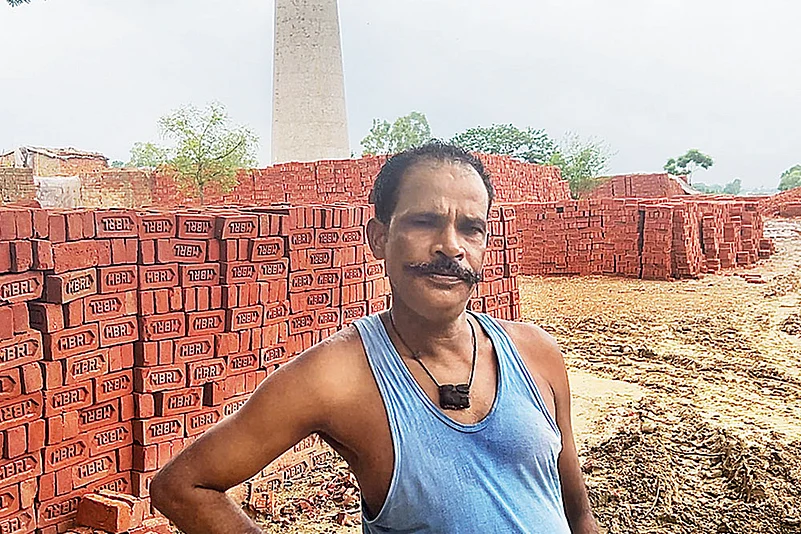Darkness falls on Rajauli village, but for Raju Kushwaha there is no difference between the scorching sun and the blazing brick kiln. While the village’s residents enjoy the cool air, the 45-year-old’s sweat-drenched body is hard at work at the local Bhatta.
Kushwaha works in one of Uttar Pradesh’s 19,718 brick kilns. Within India, there are over a 100,000 brick kilns that produce 150-200 billion bricks a year and employ 10 million workers, a report by UN’s Climate and Clean Air Initiative. This number is expected to increase as construction in India is estimated to grow at a rate of six point six per cent per year between 2005 and 2030, resulting in increased demand for materials like bricks.
The increased demand means that even as temperatures of 50 degrees and heatwave alerts rang through northern India, India’s brick kilns stayed open. “The surface was so hot that workers could cook their chapatis just by placing their utensils on top of it,” he said.
The factory where Kushwaha works is divided by function and temperature. By the entrance, where bricks are stacked for pick-up, the heat is bearable. Next to the bhatta, where workers pull out freshly baked bricks, it’s 70 degrees; inside the furnace can be between 800 to 1200 degrees. The medium-sized factory produces 20,000 bricks a day.
Tonight, he has the weekly night shift. In Rajauli, a four-by-four feet brick shack directly above the furnace, held together without mortar, is Kushwaha’s abode tonight. The room is meant to provide rest for workers on coal duty, but is hardly used, he says. Raju points to a pair of worn-out wooden slippers placed aside, “we wear these when we are on top of the bhatta, otherwise you get burns,” he says, wiping his coal-smeared face.
"Sometimes we have to stay there and add coal to the furnace at regular intervals all night," he says, wiping his coal-smeared face, “and there days it gets so hot when we feel we are being cooked just like the bricks.”
The practice isn’t new, the nighttime cool is used to minimise the impact of the extreme weather during the day. While some kilns have workers take turns during extreme hot weather, others have switched to working at night primarily. “That’s the only time we can do it (put bricks in the furnace),” says munshi Hanuman Prasad who manages and supplies labour in Barabanki’s Safdarganj, 37 minutes away from Kushwaha’s village.
Originally from Bilaspur, Chhattisgarh, Kushwaha is joined by his wife and 11-year-old daughter. His wife Sushila Bai carries baked bricks out of the kiln. She gets paid by the brick: the more she carries, the more she’s paid. “I can carry over a dozen bricks on my head at once,” she boasts. Often, to meet urgent orders, she puts on gloves and puts her hands into the furnace to pull out the bricks. In one day, Sushila makes Rs 400 to 500, depending on how fast she can work. Showing her weathered hands, she says, “Sometimes I get burned but my hands are used to it by now.”
Sushila Bai was born into a Dalit family and married into another, laughs a humourless laugh and adds, " Mazdoori is majboori."
Dalits and adivasis make up most of the brick kiln workers in India, says a report by Anti-Slavery International. “100 per cent of brick kiln moulders are from marginalised and excluded castes and classes, and 60 per cent are interstate migrant workers.” The Centre for Labour Research and Action (CLRA) 2020 census surveyed 160 to 213 families annually from 2016 to 2019 in Ajmer and Bhilwara. The study found that half the workers were Dalits, 17 per cent Adivasis, and 27 per cent were Other Backward Classes (OBC).
Amid the expanse of land dominated by shades of brown and red, a centuries-old banyan tree stands as the only green dot. The labourers sit down under its shade just for a short minute before continuing with their work.
Sitting under the banyan tree, Prasad reflects that his job is becoming harder by the generation as people don’t want to work in a kiln. “Sometimes we go to their houses to ask them to come in,” he says.
As he talks, Satyanaam a worker at Prasad’s kiln, squats besides the munshi’s chair. He unties a saffron gamcha off his head to wipe his sweaty forehead.
“My family did this work so I also do this,” he says. His sentences are punctuated gasps of air brought on by persistent coughing fits. “Today’s young men don't want to do it, maybe they don’t have the tolerance as we do,” he adds.
(This appeared in the print as 'Fahrenheit 800')


















